|
|
|
Sort Order |
|
|
|
Items / Page
|
|
|
|
|
|
|
| Srl | Item |
| 1 |
ID:
154449
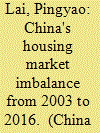

|
|
|
|
|
| Summary/Abstract |
During 2003–2016, China experienced an unprecedented housing market imbalance. The present paper applies the user cost approach to conduct a systematic analysis of this important phenomenon, examines the policy factors behind the persistent housing market imbalance, and explores policy options to correct the housing market imbalance. We found that during most of 2003–2016, the user cost was significantly lower than 2 percent, caused by high income growth, rapid credit expansion and low interest rates, which led to the persistent housing market imbalance. Therefore, the government should control bank credit and introduce property taxes during the possession of houses.
|
|
|
|
|
|
|
|
|
|
|
|
|
|
|
|
| 2 |
ID:
086260
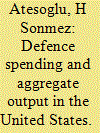

|
|
|
|
|
| Publication |
2009.
|
| Summary/Abstract |
In this article the effect of defense spending on aggregate output is discussed. Recent publications in this area are reviewed and new additional evidence is provided. The findings presented in this paper are supportive of the positive effect of defense spending. However, in light of the contrary evidence presented in other papers, empirical evidence taken as a whole, suggests that a definitive conclusion about the effect of defense spending at this time should be avoided.
|
|
|
|
|
|
|
|
|
|
|
|
|
|
|
|
| 3 |
ID:
188446
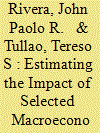

|
|
|
|
|
| Summary/Abstract |
As economic activities came to a standstill during the COVID-19 pandemic, the Philippines, like many economies across the globe, experienced rising inflation, currency depreciation and fluctuating capital markets. To manage these variables and stabilize the macroeconomy, the central bank resorted to monetary tightening. In the Philippines, a key mechanism that contributes to this stabilizing effect rests on remittances that have been cushioning the economy from the effects of volatilities and uncertainties in the global economy. During economic downturns and reduced capital flows, remittances provide support not only to recipient households but also to the country’s financial sector. Using time series analysis, we estimate the response of remittance inflows on impulses from selected macroeconomic variables, namely interest rate, inflation rate and exchange rate. A common characteristic shared by the selected indicators is their influence on recipient households’ consumption-related decision-making process. These findings warrant the need to redesign major institutional policies to manage remittances in light of their anticipated feedback effect on the economy.
|
|
|
|
|
|
|
|
|
|
|
|
|
|
|
|
| 4 |
ID:
090596
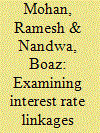

|
|
|
|
|
| Publication |
2009.
|
| Summary/Abstract |
Interest rates play an important role, not only in attracting capital inflow, but also in macroeconomic stabilization and determining asset prices. Given the interdependent nature of member countries of the Association of Southeast Asian Nations (ASEAN), it is crucial to examine whether there is any evidence of co-movement of short-term domestic interest rates within these economies. In addition, because of their significant economic influence in the region, we explore the Granger causality with China and India in determining their impact on interest rate movement in ASEAN-5 economies. We find evidence of cointegration; there is co-movement among the ASEAN interest rates. Further, based on the causality test, we find that China exerts more influence on the direction of the interest rates in the region.
|
|
|
|
|
|
|
|
|
|
|
|
|
|
|
|
| 5 |
ID:
117804


|
|
|
|
|
| Publication |
2012.
|
| Summary/Abstract |
This article explores the consequences of financial liberalization policy on the banking sector in Bangladesh. Following a motivating portfolio selection theor-etical model on the impact of liberalization, it applies time series techniques with annual banking sector data for the period 1981-2008. The study suggests that the main objective of financial liberalization to promote domestic private savings by raising real interest rates has not worked. No significant positive correlation is observed between domestic private savings and the real deposit interest rate.
|
|
|
|
|
|
|
|
|
|
|
|
|
|
|
|
| 6 |
ID:
108356
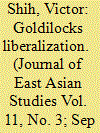

|
|
|
|
|
| Publication |
2011.
|
| Summary/Abstract |
Nearly two decades after central bankers began to call for interest rate liberalization, the central bank continues to impose stringent rules on the fluctuation of deposit interest rates. This seems an unlikely outcome given widespread endorsement of liberalization by technocrats and experts both in and out of the government, China's accession to the World Trade Organization, and the technocrats' insulation from popular pressure. To be sure, local interests and central bank lobbying have driven gradual liberalization of interest rates. However, senior Chinese technocrats held on to control over interest rates because of their need to maintain state banks' dominance and to mobilize bank funds in times of economic downturns. As such, progress toward interest rate liberalization only to ok place during "Goldilocks" phases when the economy enjoyed healthy growth without high inflation.
|
|
|
|
|
|
|
|
|
|
|
|
|
|
|
|
| 7 |
ID:
171880
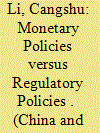

|
|
|
|
|
| Summary/Abstract |
This paper studies how monetary and regulatory policies manage peer to peer (P2P) interest rates. Based on selected representative monetary and regulatory policies, this paper nds that easy monetary policies reduce the demand for online loans, thus reducing the market’s interest rates. Monetary policies may increase the supply of online loans through rational expectation channels or reduce the demand for online loans through bank risk-taking channels. Normative market-based regulatory policy enables the P2P market to return to rationality, eliminates high-risk investors and borrowers, and subsequently reduces market interest rates. Risk disposal-based regulatory policy reduces market supply to some extent, resulting in a small increase in interest rates. Both easy monetary policies and regulatory policies have a great impact on the normal platforms. The interest rate of high-risk platforms is less affected by the relevant policies, which is evidence that such platforms do not behave in accordance with the nancial rules in general. Monetary policies mainly affect platforms with interest rates in a relatively normal range, while regulatory policies mainly focus on platforms with abnormal interest rates.
|
|
|
|
|
|
|
|
|
|
|
|
|
|
|
|
| 8 |
ID:
159054
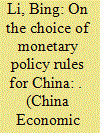

|
|
|
|
|
| Summary/Abstract |
Motivated by the institutional features of China's monetary policy, this paper aims at identifying the most data favored monetary policy rule for China within a dynamic stochastic general equilibrium (DSGE) model framework. In a canonical New-Keynesian DSGE model, we carry out a positive analysis by employing Bayesian methods to estimate three main categories of monetary policy rules, namely a Taylor-type interest rate rule, a money growth rule and an expanded Taylor rule with money. Based on China's quarterly data from 1996Q2 to 2015Q4, our estimation shows that the expanded Taylor rule obtains the best empirical fit to the data. Moreover, impulse responses and forecast error variance decompositions demonstrate that monetary policy rules with or without money provide very different implications for the policy behavior. Our results ultimately suggest that money has so far been more closely targeted than nominal interest rate and still plays an important role as a monetary policy target in China. Furthermore, a conventional Taylor-type interest rate rule is not good enough yet to describe China's monetary policy behavior.
|
|
|
|
|
|
|
|
|
|
|
|
|
|
|
|
| 9 |
ID:
121804
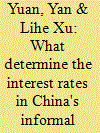

|
|
|
|
|
| Publication |
2013.
|
| Summary/Abstract |
The interest rate is one of the most important factors in farmers' decision-making of borrowing and lending in the informal financial market in China. This paper explores the determinants of the interest rate with microfinance data. Results show that the income disparity, the relationship between borrowers and lenders, the usage of borrowing, and formal credit constraints are important factors affecting interest rates. More importantly, to borrow from those in the higher income hierarchy, farmers have to bear higher interest rates. We attribute this to different social capitals across income groups and higher default risks for the poor. This paper contributes to a better understanding of the informal financial market in rural China and sheds light on the mechanism of higher informal interest rate formation.
|
|
|
|
|
|
|
|
|
|
|
|
|
|
|
|
| 10 |
ID:
107995


|
|
|
|
|
| Publication |
2011.
|
| Summary/Abstract |
The international dollar standard is malfunctioning. Near-zero US short-term interest rates launch massive hot money outflows into emerging markets (EM) in Asia and Latin America. Each EM central bank buys dollars to prevent its currency from appreciating but loses monetary control. Despite some appreciation, average inflation in EMs is now much higher than in the old industrial economies and world commodity prices are bid up sharply. This inflation on the dollar's periphery only registers in the US CPI with a long lag. However, the more immediate effect of the Fed's zero interest rate is to upset the process of bank intermediation within the American economy. Bank credit continues to decline while employment languishes. Therefore, constructive international monetary reform calls for the Fed to abandon its zero-interest rate policy, which is best done in cooperation with the European Central Bank, the Bank of Japan, and the Bank of England also abandoning their ultra low interest rates.
|
|
|
|
|
|
|
|
|
|
|
|
|
|
|
|
|
|
|
|
|